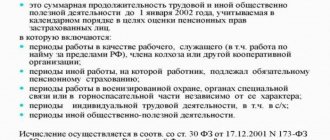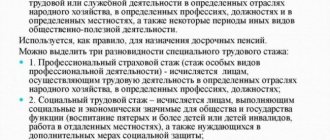What periods are included in the insurance period?
The insurance period does not include periods of unemployment, but in addition to work under employment contracts, it includes other periods (according to Federal Law No. 400 of December 28, 2013 “On insurance pensions”). An important condition: these periods must be preceded or followed by periods of work. If the periods coincide, then only one of them will be included in the length of service.
- The employee served in the military or served in law enforcement;
- the employee received compulsory social insurance benefits for temporary disability;
- the entrepreneur worked for himself and paid his own fees, the same applies to notaries, lawyers, detectives;
- the person worked as a deputy or clergyman, a member of a collective farm or production cooperative;
- mother or father cared for a child up to 3 years old (but no more than 6 years in total);
- the unemployed received benefits at the labor exchange, participated in paid public works, and traveled to another area for employment in the direction of the labor exchange;
- the employee was unjustifiably prosecuted, suspended from work and placed in custody;
- the convicted person worked in prison and fulfilled his quota; the employee cared for a disabled person of group 1, an elderly person over 80 years old or a disabled child;
- the spouse of a contract serviceman lived in an area where it was impossible to get a job (but not more than 5 years in total);
- for spouses of consuls and employees of diplomatic services and missions abroad - periods of residence in another country, but not more than 5 years.
The value of experience
The main objective of the length of service is to give citizens the opportunity to take advantage of various social guarantees provided by the state. Among such social guarantees are:
- Registration of maternity payments;
- Receiving compensation for time of incapacity;
- Assignment of pension provision.
The calculation of the number of insurance years is carried out both quantitatively and qualitatively. If the quantitative method is used, the worker can retire upon reaching retirement age.
When calculating length of service using the qualitative method, factors of production and working conditions that can reduce the indicators are taken into account. As a result, a person has the right to receive a pension on a preferential basis until he reaches the age specified by law.
Each individual case of applying for a pension on preferential terms has its own criteria regarding the accumulated years of insurance experience.
Do not confuse insurance and work experience
The concepts of insurance and work experience are often confused, but they differ fundamentally:
The insurance period is the time when insurance premiums were paid for the employee (plus the periods listed above).
Work experience is the sum of all periods of an employee’s work activity.
The main difference is that the length of service includes all vacation periods at your own expense. They will not be included in the insurance period, because at that time no insurance premiums were deducted for the employee.
Continuity is not important
For the purposes of assigning benefits for temporary disability and pregnancy and childbirth, the insurance period is understood as the time that the employee worked (part 1, 1.1 of article 16 of the Federal Law of December 29, 2006 No. 255-FZ, clause 2, 2.1 of the Rules, approved by order Ministry of Health and Social Development of Russia dated 02/06/2007 No. 91):
- under an employment contract;
- was in the service (military, civilian, etc., named in Federal Law No. 4468-1 of February 12, 1993);
- was engaged in other activities subject to social insurance in case of temporary disability and in connection with maternity.
The insurance period is calculated in full years and months and is confirmed by entries in the work book, military ID, etc. (section II of the Rules, approved by order of the Ministry of Health and Social Development of Russia dated February 6, 2007 No. 91).
Continuity of service currently has no meaning. An employee's breaks from work can be of any duration. They do not affect the calculation of the insurance period. What length of service is needed for sick leave: general or continuous? Of course, general (clause 2 of the Rules, approved by order of the Ministry of Health and Social Development of Russia dated 02/06/2007 No. 91, determination of the Constitutional Court of the Russian Federation dated 03/02/2006 No. 16-O). After all, the concept of continuity of work experience has sunk into oblivion.
How to calculate the insurance period
You will find the legislative basis for calculating the insurance period in Art. 13 of the Federal Law “On Insurance Pensions” No. 400-FZ dated December 28, 2013. All the nuances for calculating the insurance period, including astronauts, military personnel, sailors, and workers in hazardous industries, are listed here.
For calculations, you need a work book with all inserts. If the book is lost, the employee can provide all employment contracts with employers or confirm his work activity in court with the help of two or more witnesses. When calculating work experience, certificates from the place of work about periods of work, certificates from archives about periods of work, a military ID, and an extract from the terms of work of an individual entrepreneur are also accepted.
To calculate experience, you need:
- calculate the length of service using the work book;
- exclude periods of work abroad from the length of service;
- include in the insurance period periods when a person worked as an individual entrepreneur or farmer and paid insurance premiums for himself;
- exclude periods when the employee received a pension - for disability or labor;
- If the periods coincide, count only one.
Today, calculating the insurance period is not so difficult: data on insurance contributions is available in the Pension Fund and is stored on electronic media.
Application for recalculation of sick leave
An employee has the right to demand from his own management a recalculation of the amounts paid on his sick leave . And the employer is legally obliged to fulfill all requirements if:
- the certificate of incapacity for work contains a note indicating a violation of the regime by the employee,
- the organization decided to increase wages during the period included in the calculation,
- An error was discovered when calculating periods.
This is only feasible if the employee, having said goodbye to one company, ended up in another, and did not provide a salary certificate.
Thus, an employee may request a recalculation of all sick leave paid to him, but only if he was provided with a document on income for a time period not exceeding three years .
Download a sample application for recalculation of sick leave here.
Although, according to the law, the employer is obliged to satisfy his employee’s request for recalculation, the timing of the fulfillment of this request is not regulated in any way by law , and therefore, under certain circumstances, the employer and the employee may have a conflict, and, among other things, entail sanctions from the Social Insurance Fund.
Why calculate insurance experience?
The size of the pension depends on the insurance period; it is calculated upon retirement. The amount of sick leave benefits also depends on the length of insurance coverage. The length of sick leave is calculated on the day of the onset of temporary disability:
- for less than 5 years of experience, the benefit is 60% of the salary;
- with 5-8 years of experience, the benefit is 80% of the salary;
- with more than 8 years of experience, the benefit is 100% of the salary.
But keep in mind: the insurance period for calculating sick leave does not include periods of child care up to 1.5 years.
Types of experience
Work experience means the entire period of a person’s official work in the Russian Federation.
Insurance length of service refers to periods of work or other activities performed on the territory of the Russian Federation during which the employer made contributions to the Pension Fund for its employee.
Non-insurance period is the time when a person did not actually fulfill his work duties and deductions were not made for him, but this time is still recorded in the length of service. Such periods include periods of illness, military service, caring for a sick relative, and some other situations.
Examples of calculating insurance period
Example 1 . An employee applies for a pension upon reaching retirement age. The work experience according to the work book is 28 years, during which time she once went on maternity leave for three years. Before that, she was an entrepreneur for 5 years.
The insurance period for calculating the pension includes only child care leave of up to 1.5 years, so we will subtract the period from 1.5 to 3 years from the insurance period. And let’s add 5 years of entrepreneurship:
28 - 1.5 + 5 = 31.5 years.
This length of service will be used to calculate the insurance part of the pension.
Example 2 . With the help of a work book, extracts from the state register and other certificates, we know about the employee’s working periods:
- length of service until 2002 is 20 years;
- from January 1, 2002 to May 16, 2009 he worked at Sosna and Oliva LLC;
- from May 25, 2009 to October 14, 2014 he worked at Melchior JSC;
- from June 10, 2014 to February 5, 2021, he worked as an individual entrepreneur.
We sum up the working periods, take into account the overlap, we get 37 years, 29 days.
CONTINUOUS EXPERIENCE IS A thing of the past
An employee of the Sistema research and production association, Vladimir Kornilov from Tver, single-handedly changed the social security system
(Arguments i time" 06/15/2006)
Dissatisfied with the results of the amount of sick leave, he filed a lawsuit in the Constitutional Court and recently won the case. As a result, from January 1, 2007, continuous work experience as a norm will cease to exist.
After working for sixteen years at the Tver Carriage Works, Kornilov resigned of his own free will. After 7 months, he got a job at Sistema LLC. When I got sick, I received benefits in the amount of 60% of my average earnings. Because according to the rules of compulsory social insurance, temporary disability benefits depend on the number of years worked without a break. Let’s say that if a person has a continuous work experience of up to 5 years, then the benefit amount is 60%, if up to 8 - 80%. And only if a person has worked continuously for more than 8 years, he has the right to receive the average salary. The benefit is calculated based on average earnings for the 12 months preceding the illness.
However, Vladimir Petrovich decided that such an attitude towards people was unfair. In his opinion, the amount of temporary disability benefits, the conditions and procedure for its payment should not depend on the length of continuous work experience. The Constitutional Court considered his arguments legitimate and sided with the ordinary citizen. Thanks to this turn of events, millions of working Russians can now breathe easy and not worry that they have so few years of work experience in their “work baggage.” And if they suddenly get sick, their benefit amount will depend on their continuous work experience.
A new regulatory document is currently being prepared, which should correct the existing procedure and regulate issues of calculating benefits for temporary disability. It is not yet known exactly what length of service legislators will take as a basis for general labor or insurance. Until this law is adopted, benefits will be calculated as before.
WHAT DOES THIS THREATEN US?
The adoption of the new bill is still a long way off, so the regulations on the calculation of continuous work experience remain in effect. But there are a lot of nuances when using them. To clarify what length of service exists, and also to tell in more detail what threatens the interruption of work experience, we asked the head of the department of application of legislation in the field of compulsory social insurance of the Social Insurance Fund of the Russian Federation, Lidiya Novitskaya
.
Was the Social Insurance Fund ready for the decision of the Constitutional Court?
Calculation of benefits taking into account continuous work experience has become irrelevant for a long time. We have repeatedly raised the issue that with changes in the economic situation in the country, the amount of benefits may depend on insurance or general work experience. But not from continuous.
What periods are currently acceptable between breaks in work so that the length of service is not interrupted?
When transferring from one job to another, continuous length of service is maintained if the break does not exceed one month. In case of dismissal at one's own request without good reason, continuous work experience is retained if the break in work does not exceed three weeks. If an employee was dismissed due to staff reduction, a break in work of up to three months is allowed. And when a person is transferred to work in another area, continuous work experience is maintained during the entire “moving” period. At the same time, the work experience of the other half is maintained until the husband or wife finds a job.
What is the difference between total length of service and insurance length?
The total length of service is the time during which the employee was in an employment relationship. And the insurance period is the period when a person is not in an employment relationship, but transfers funds for compulsory social insurance himself (or for him).
Are studies in secondary specialized institutions, universities and military service counted towards continuous work experience?
Studying in all educational institutions, regardless of organizational and legal status, does not interrupt work experience, but is not taken into account when determining it. For example, if a person worked for two years before studying at a university, then his work experience after graduation will be two years. However, if during your studies you underwent practical training and were paid a salary for this, then this period will be counted as continuous work experience.
The years spent in a vocational school are counted towards continuous work experience.
In the army, among conscripts, a day of service is counted as two. If a guy had no work experience before being drafted, then when he serves for two years and is demobilized, his work experience will be 4 years. For contract soldiers, their normal routine goes on day after day.
In addition, military personnel have their own characteristics of maintaining continuous work experience. A person can be discharged from the army and go to work within a year, while his continuous work experience is maintained.
How is continuous work experience calculated for women who were on maternity leave or quit to care for a child?
Continuous work experience is maintained for women for child care up to 14 years of age, and for caring for a disabled child up to 18 years. At the same time, a woman can repeatedly quit and get a job, regardless of the break between jobs. Her experience, which was on the child’s birthday, will remain, and if she worked, then these years or months will be added.
If a person is registered with the employment service, is his length of service retained?
Yes.
Under what circumstances is continuous work experience not maintained?
In case of absenteeism, violation of labor protection, systematic failure to fulfill one’s duties without good reason, theft at work. This is provided for in paragraph 7 of the Rules for calculating the continuous length of service of workers and employees when assigning temporary disability benefits.







